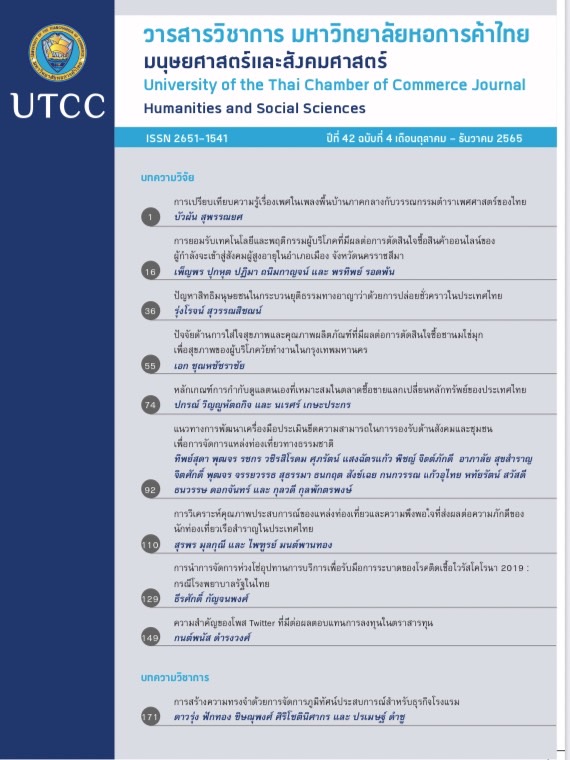Health Concern and Product Factors influencing Working Adults Decision Making in Buying Bubble Milk Tea in Bangkok
Main Article Content
Abstract
The objectives of this study were to evaluate health consciousness trend and product quality affected on a group of customers who are professional workers, especially first jobbers who work and live in the city of Bangkok. This research had studied their purchasing decisions by focusing on popular beverages like healthy bubble tea. The sample consisted of 400 workers
working in Bangkok and had experience in consuming healthy bubble tea. Data collection was done by randomly asking sampling to fill out the questionnaire. The data analysis was done using descriptive statistics as percentage, mean, and standard deviation and multiple regression analysis for hypotheses testing.
The results found that most respondents were female, aged between 22-30. The average monthly income is between 20,000-30,000 Baht. The results revealed that workers in Bangkok were mostly concerned about the freshness and hygiene of ingredients. The hypothesis testing found that health consciousness and product quality affected workers purchasing decisions of healthy bubble tea at the statistically significant level of 0.05. The goal of this study is to obtain new knowledge in the context of studying consumer attitudes and behaviors of working class in Bangkok, which has an economically significant population of Thailand which affects buying pattern of bubble tea in terms of health awareness. These shall be beneficial to stakeholders
to understand and be able to create a value proposition for the brand as well as determine marketing strategies or create a business plan to meet today’s consumer expectations.
Article Details

This work is licensed under a Creative Commons Attribution-NonCommercial-NoDerivatives 4.0 International License.
ลิขสิทธิ์ของบทความ
ผลงานที่ได้รับการตีพิมพ์ถือเป็นลิขสิทธิ์ของมหาวิทยาลัยหอการค้าไทย ห้ามมิให้นำเนื้อหา ทัศนะ หรือข้อคิดเห็นใด ๆ ของผลงานไปทำซ้ำ ดัดแปลง หรือเผยแพร่ ไม่ว่าทั้งหมดหรือบางส่วนโดยไม่ได้รับอนุญาตเป็นลายลักษณ์อักษรจากมหาวิทยาลัยหอการค้าไทยก่อน
References
กตัญญู คณิตศาตรานนท์. (2558). การรับรู้คุณภาพและการสื่อสารทางการตลาดที่ส่งผลต่อการตัดสินใจซื้อผลิตภัณฑ์ ประเภทผักออร์แกนิคของประชาชนในเขตกรุงเทพมหานคร (ภาคนิพนธ์ปริญญามหาบัณฑิตไม่ได้ตีพิมพ์). มหาวิทยาลัยกรุงเทพ.
เกอ ซ่ง. (2559). คุณภาพอาหาร คุณภาพการบริการ สภาพแวดล้อมทางกายภาพและความใส่ใจในสุขภาพที่ส่งผลต่อการตัดสินใจเลือกใช้บริการร้านอาหารไทยของนักท่องเที่ยวชาวจีนในกรุงเทพมหานคร (ภาคนิพนธ์ปริญญามหาบัณฑิต ไม่ได้ตีพิมพ์). มหาวิทยาลัยกรุงเทพ
ไทยป่วนเบาหวานพุ่งสูงต่อเนื่อง แตะ 4.8 ล้านคน คาดถึง 5.3 ล้านคนในปี 2583. (2562, 13 พฤศจิกายน). Hfocus เจาะลึกระบบสุขภาพ. สืบค้นจาก www.hfocus.org/content/2019/11/18031
นรภัทร ยกชม. (2562). กระบวนการตัดสินใจเลือกบริโภคเครื่องดื่มชาไข ่มุกของกลุ ่มประชากรในเขต กรุงเทพมหานคร (วิทยานิพนธ์ปริญญามหาบัณฑิต ไม่ได้ตีพิมพ์). มหาวิทยาลัยรามคำแหง, กรุงเทพฯ.
นีลเส็น’ เผย “เทรนด์รักสุขภาพ” โต แนะผู้ผลิตเสนอสินค้าและบริการตอบโจทย์. (2562, 7 เมษายน). ฐานเศรษฐกิจ. สืบค้นจาก www.thansettakij.com/content/398882
ปัทมาวรรณ ลิ้มพลอยพิพัฒน์. (2564). พฤติกรรมการดูแลสุขภาพและการรับรู้คุณค่าตราสินค้าทีส่งผลต่อพฤติกรรมการตดัสินใจซื้อชานมไข่มุกเพื่อสุขภาพของผู้บริโภคในเขตกรุงเทพมหานคร (วิทยานิพนธ์ ปริญญามหาบัณฑิต ไม่ได้ตีพิมพ์). มหาวิทยาลัยบูรพา, ชลบุรี.
พาไปดู!! เทรนด์อาหารและเครื่องดื่ม 2020. (2562, 27สิงหาคม). มติชนออนไลน์. สืบค้นจาก www.matichon. co.th/publicize/news_1644719
เมธินี ทุกข์จาก. (2559). การคล้อยตามกลุ่มอ้างอิง การใส่ใจสุขภาพ คุณภาพของผลิตภัณฑ์ ความโปร่งใสด้านราคา และ ทัศนคติต่อการซื้อที่ส่งผลต่อความตั้งใจซื้อผลิตภัณฑ์อาหารเวย์โปรตีนของผู้บริโภคเจนเนอเรชั่นวาย (Generation Y) ในกรุงเทพมหานคร (ภาคนิพนธ์ปริญญามหาบัณฑิต ไม่ได้ตีพิมพ์). มหาวิทยาลัยกรุงเทพ.
ศูนย์อัจฉริยะเพื่ออุตสาหกรรมอาหาร. (2562). อาหารเครื่องดื่มเพื่อสุขภาพและความเป็นอยู่ที่ดีในประเทศไทย. สืบค้นเมื่อ 21 กุมภาพันธ์ 2563, จาก http://fic.nfi.or.th/MarketOverviewDomesticDetail. php?id=271
สรินยา อารีย์รักษ์. (2562). กระบวนการตัดสินใจบริโภคชานมไข่มุกของประชาชนในเขตกรุงเทพมหานครและปริมณฑล (การค้นคว้าอิสระปริญญามหาบัณฑิต, มหาวิทยาลัยรามคำแหง). สืบค้นจาก https://www.ru.ac.th/MMM/IS/mlw11/sec1/6014963011.pdf
สุพัตราอำนวยเกียรติ. (2559). ทัศนคติต่อสุขภาพ รูปแบบการดำเนินชีวิตและการโฆษณาผ่านระบบอินเทอร์เน็ตที่มีอิทธิพลต่อการตัดสินใจซื้ออาหารเพื่อสุขภาพของผู้บริโภคในกรุงเทพมหานคร (ภาคนิพนธ์ปริญญามหาบัณฑิต ไม่ได้ตีพิมพ์). มหาวิทยาลัยกรุงเทพ.
อรรถเกียรติกาญจนพิบูลวงศ์, ภาณุวัฒน์ คำวังสง่า, และ สุทธิดา แก้วทา (2562). รายงานสถานการณ์โลก NCDs เบาหวาน ความดันโลหิตสูง และปัจจัยเสี่ยงที่เกี่ยวข้อง. กลุ่มเทคโนโลยีระบาดวิทยา และมาตรการชุมชน กองโรคไม่ติดต่อ กรมควบคุมโรค กระทรวงสาธารณสุข.
Cochran, W. G. (1953). Sampling techiques. New York, NY: Wiley
Gould, S. J. (1988). Consumer attitudes toward health and health care: A differential perspective.Journal of Consumer Affairs, 22(1), 96-118. doi:10.1111/j.1745-6606.1988.tb00215.x
Hu, C. S. (2013). A new measure for health consciousness: Development of a health consciousness conceptual model. Paper presented at the National Communication Association Annual Conference, November 2013. Retrieved from https://www.researchgate.net/publication/299484743_A_New_Measure_for_Health_Consciousness_Development_of_A_Health_ Consciousness_Conceptual_Mode
Kotler, P. (2003). Marketing management (11th ed.). Upper Saddle River, NJ: Prentice-Hall.
Kotler, P., & Keller, K. (2012). Marketing and management (14th ed.). Upper Saddle River, NJ: Pearson Prentice Hall.
Nalisa. (2019). Marketing Movement. Retrieved from www.marketeeronline.co
Nisbett, R., & Wilson,T. D. (1997).Thehaloeffect:Evidence forunconscious alterationof judgments. Journal of Personality and Social Psychology, 35(4),250-256.doi:10.1037/0022-3514.35.4.250
Osterwalder, A., & Pigneur, Y. (2010). Business model generation. New York, NY: Wiley.
Rützler, H. (2022). Food Trends 2023: The Future of Food and Eating. Retrieved from https://www. zukunftsinstitut.de/artikel/food/food-trends-hanni-ruetzler-en/
Sulek, J. M., & Hensley, R. L. (2004). The relative importance of food, atmosphere, and fairness of wait. Cornell Hotel and Restaurant Administration Quarterly, 45(3), 235-247


